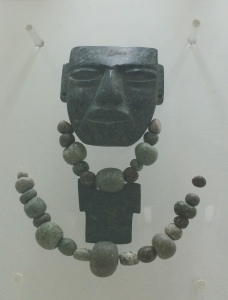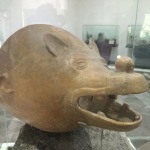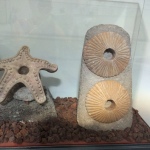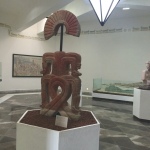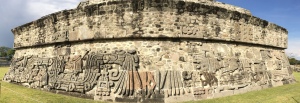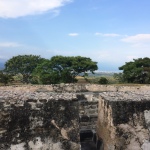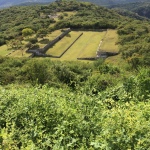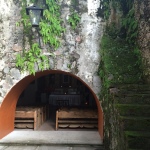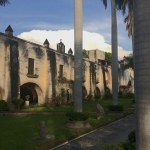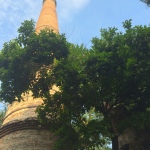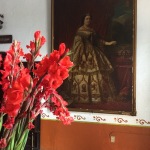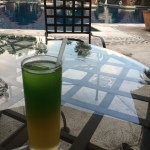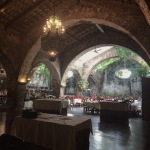Cuernavaca – Dias 3 & 4
Tuesday was pretty laid back – amazing huevos rancheros for breakfast, classes, then soup and tuna salad for lunch. After lunch, I took a siesta and stayed in that evening doing homework, blogging, and uploading photos.
Wednesday was much more interesting. Sopes for breakfast, then I walked to school. Towards the end of our afternoon conversation class, a group of us (9 students in total) skipped out early to go on a field trip. Our host families had packed up lunches, and we ate in the van. It was about an hour drive to our first stop, the archeological site of Xochicalco. For those following this as a food blog, my lunch was a couple of sandwiches with queso panela (one with tomatoes and lettuce, the other with sweet guayaba), a banana, an apple, and a little pan dulce (sweet bread, but not like a brain “sweet breadâ€, actual bread that is sweet, like a little cake).
Our driver and guide for the trip was Edgar, a man who works at the school (his mom, Rosita, is the family host coordinator for the school). First he took us to the museum and showed us around – he was very knowledgeable and it was great having a semi-private tour. The museum was built in the 90s and is a very green building – it has double stone walls to stay cool, LED lights, skylights in every room, water collection, and runs completely on solar power and water they save from rain (unless it’s super dry, in which case they sometimes have to bring in water).
The museum isn’t huge or full of artifacts, but it is very well organized – there are six rooms that showcase different characteristics of the civilization such as diet/food, religion, architecture, etc. The site dates back to AD 700-900 and it is speculated that Xochicalco played a role in the fall of Teotihuacan. Iconic masks bearing resemblance to those from Teotihuacan have been found in Xochicalco. At its peak, the city and surrounding area may have had a population of more than 20,000 people. At some point around AD 900, the city was destroyed, burned, and abandoned.
- A pot in the form of a Xoloitzcuintli, a Mexican hairless dog.
- Decorative features that resemble shells found in Xochicalco (which is very land-locked).
- The Red Lord, a sacred figure representing the sun (on top), corn (in the middle), and roots and the ground (at the base).
After Egar walked us through the museum, we drove a very short distance to the archeological site. Since it was the afternoon on a week day, there was hardly anyone at the site or the museum – it was nice to have it to ourselves, more or less. Walking up the path to the first level of the site, we saw a big black iguana – she pretty quickly ducked into her borrow when we passed by. The first level of the site is the level for the commoners and is where the market place and plaza would have been. The main pyramid on the first level provides an acoustic shield that bounces sound back so that an official could stand near the top and talk to thousands of assembled people. When you clap, you can hear the echo very clearly (although it doesn’t do that cool “ping†that the pyramids in Chichen Itza do).
Nothing at Xochicalco was quite as grand or spectacular as the large pyramids or the ball court at Chichen Itza, but the site was just as interesting. It’s on a hill, so the view was incredible and they allow you to climb the pyramids and all the levels of the site. The Temple of the Feathered Serpent, which is highest, and most important of the temples at the site, has very clearly engraved carvings. The site features two ball courts, both of which are fairly off limits but well in view. There is also the remains of the sweat-baths where the shamans and the ball players took peyote and convened with the gods.
- Remains of the sweat-baths
- The smaller of the two ball courts, with the remains of a school in the background.
We walked around the majority of the site and returned to the van to head to our next destination, Hacienda Visa Hermosa. The hacienda was built in 1592 for Hernán Cortés as a home, fort, and sugar cane plantation and refinery. It was renovated in 1945 and is now a resort hotel. The grounds are beautiful, and it’s sordid history is readily apparent. I was most impressed by the inclusion of nature among the old buildings – there is a small church where they hold wedding ceremonies that looks like a hobbit church, with tress and vines growing through out the bricks. There’s a large room in the restaurant with an open ceiling and trees, and vines, and branches, and a chandelier.
- The small church – for hobbits, I presume.
- Hacienda Vista Hermosa – as seen from inside the center courtyard.
- The smoke stack from the sugar refinery.
- La reina de Espana – inside the lobby of la Hacienda Vista Hermosa.
Outside there is a giant, beautiful swimming pool and a big patio where we had drinks. I had a Vistahermosa, which was a tequila drink with lime and fruit juice. After sitting outside with the group for a while, we left the Hacienda via the tunnels where at various times slaves and prisoners lived. There’s a second bar, La Taverna, down in the tunnels that is only open on the weekend. When Cortes’ soliders lived at the Hacienda, they weren’t allowed to make their own rum (even though they lived on a sugar cane plantation – they were supposed to only buy rum and alcohol from Spain), but of course they made their own booze and hid it down in the tunnels. After retreating through the passageways, we got in the van and returned to Cuernavaca.
I definitely want to return to stay for a night or two at the Hacienda – I looked it up and you can get rooms starting at $90 per night which is really insane, in the states it’d be hundreds and hundreds of dollars (not that there is anything in the state that compares, history-wise).
- My Vistahermosa cocktail.
- The swimming pool (well, part of the swimming pool)
- The restaurant, the room in the back is the one that is open to the jungle.
Browse Timeline
- (older) Cuernavaca – Dias 1 & 2


